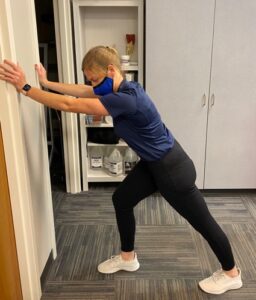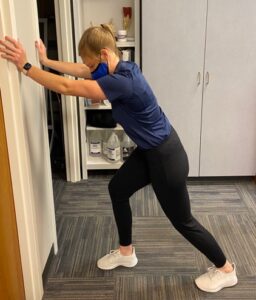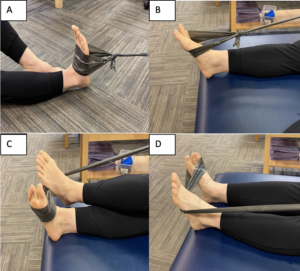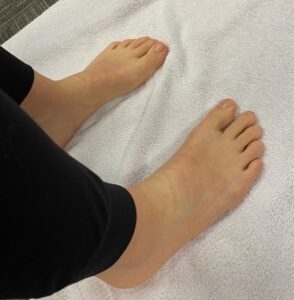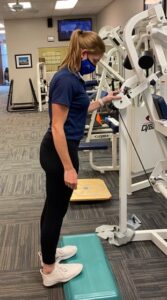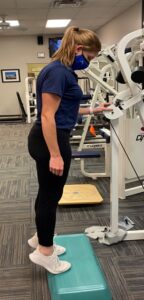Plantar Fasciitis
It happens almost every morning.
You wake up, step out of bed, and you feel a sharp, jolting pain through your heel. Or perhaps it happens after sitting down for a while. You try to walk it off and it gets a bit better, but after being on your feet too much the pain comes back. It’s stubborn, it hurts, and it doesn’t seem to want to go away. Sound familiar? You could be experiencing a common musculoskeletal condition known as plantar fasciitis.
What is Plantar Fasciitis?
The plantar fascia, is a thick layer of connective tissue that spans from your calcaneus (or heel) across the sole of your foot towards your toes. This band of deep tissue serves to support the arch of your foot and provide protection for deeper structures. Sometimes, this tissue can become painful as a result of repetitive, overloading stresses placed upon it. These stresses cause damage to the tissue, resulting in an inflammatory response that causes stiffness and pain felt at the heel.
How did I get Plantar Fasciitis?
While there are a lot of potential causes for plantar fasciitis, a lot is still unknown about how the condition is brought on. Some common risk factors associated with developing plantar fasciitis include tightness of the calves, wearing shoes with poor support, having a high arch of the foot, obesity, participation in repetitive impact sports (such as running), and a recent increase in exercise intensity. The condition is typically insidious, and it’s often impossible to determine the exact source of the onset.
What can I do?
There are several exercises and measures commonly prescribed to help relieve plantar fasciitis pain and address potential root causes of the condition. Give them a try 1-2x/day every day for 4-6 weeks.
- Calf Stretch (Figure 1a&b)
- Why this exercise?: Plantar fasciitis may be associated with reduced flexibility of the muscles that make up your calf: the gastrocnemius and soleus. This stretch aims to improve the extensibility of both.
- How to perform: Stand near a wall with your unaffected foot in front and the affected foot behind you. Lean forward to the wall while keeping your knee straight until you feel a good, comfortable stretch along your calf (gastroc stretch, Figure 1a). Hold this position for 2 minutes, then repeat with your knee slightly bent (soleus stretch, Figure 1b). For a deeper stretch, stand on a step or sturdy box with the affected heel off the edge.
- 4-Way Ankle Active Range of Motion w/ Resistance Band (Figures 2a-d)
- Why this exercise?: Any weakness on the musculature that controls ankle motion, particularly inversion, could result in excessive force being placed through the plantar fascia. Strengthening the ankle in these 4 motions improves strength to allow for better translation of force from the plantar fascia during weight bearing.
- How to perform: Make a loop in the resistance band large enough to place around ball of the affected foot. Tie the end of the band around a sturdy object (ie a bed post) and place the loop around the affected foot. Flex your foot up (toes up to your nose) against the tension of the band for 3 sets of 10 reps (Figure 2a). Next, untie the band and hold the end of the band with your hands. With the loop still around your foot, point your toes against the band in a slow, controlled manner for 3 sets of 10 reps (Figure 2b). For the next position, keeping the tied loop around your affected foot, cross your other foot over to place tension on the length of the band. Turn your foot inward against the resistance of the band for 3 set of 10 reps (Figure 2c). For the final exercise, keeping the tied loop around your affected foot, place the length of the band around the ball of your other foot and hold. Move the pinky toe edge of your foot out away from midline for 3 sets of 10 reps (Figure 2d).
- Towel Scrunches (Figure 3)
- Why this exercise?: This exercise works some of the muscles that support the arch of your foot. Strengthening these muscles will help improve your foot stability and mobility, which will help relieve some stress on your plantar fascia and allow for it to heal.
- How to perform: Lay out a towel on the floor and place affected foot on top. Using your toes, scrunch up the towel. Perform for 3 minutes sitting down and standing up.
- Bilateral Heel Raises (Figure 4)
- Why this exercise?: Heel raises work your calf muscles to help build strength, which will help distribute damaging impact forces away from the plantar fascia when walking, running, etc.
- How to perform: Stand on a step or sturdy box with both heels off the edge. Make sure there is something to hold on to for balance (ie a railing or wall). Lift your heels up to stand on your toes, then slowly lower your heels back down. Perform 20-30 reps. Too easy on both feet? Try doing the heel raises while standing on the affected foot only.
- Single Leg Balance (Figure 5)
- Why this exercise?: Incorporating balance work into your routine will improve stability of both your hips and ankles with motion, which will help take stress off of supportive structures like your plantar fascia.
- How to perform: Stand in front of a sturdy structure for support, but try not to use it if possible. Lift the unaffected leg to stand on the affected foot. Hold the balance for 10 seconds. Repeat 10 times. Too easy? Try it standing on a small pillow or towel.
I tried the exercises, now what?
Hopefully after 4-6 weeks of doing these exercises, you will notice a difference in the intensity of your pain. If not, it is recommended that you see a physical therapist for a more thorough assessment. You and your physical therapist can discuss all potential options and find the solution that will get you back to enjoying life as soon as possible!
